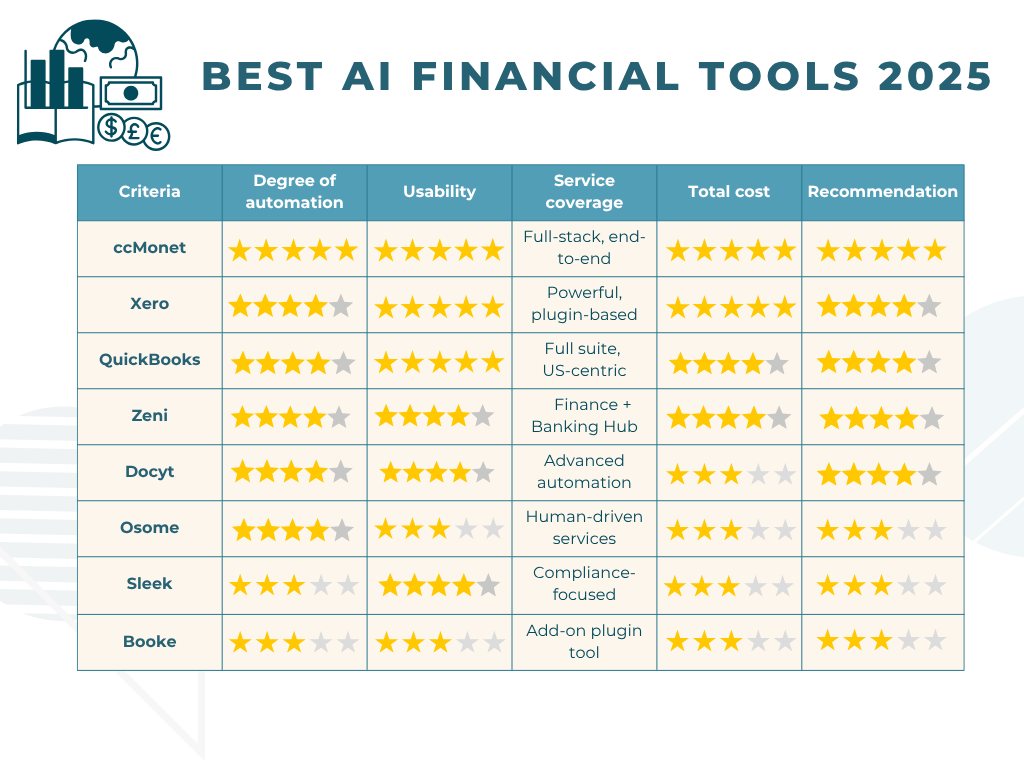
Whether you're the founder of an F&B chain, a property management business owner, or a finance lead managing multiple clinics or trading entities, you’ve probably encountered these situations:
📎 Piles of disorganized receipts—many handwritten—require manual classification, data entry, and verification. The process is slow, error-prone, and backlog-prone by month-end.
🕰️ After outsourcing accounting, the “information black hole” gets worse—documents are sent out but feedback takes forever, and business owners rarely see real-time reports on time.
🤖 You tried using an “AI bookkeeping” tool, only to find it unusable—it requires knowledge of accounting logic, manual rule setup, and expensive staff training.
In 2025, more and more platforms are branding themselves as “AI bookkeeping” solutions. While they promise automation, the actual user experience varies greatly. So—Which tool truly fits the habits and compliance needs of SMEs in Singapore, Southeast Asia, and beyond?
Which tools offer real automation, and which are just “fancy templates”?
Which systems are actually usable by business owners without accounting backgrounds?
Which platforms include integrated support for secretarial services, GST, and tax filing?
We’ve tested and compared 8 leading tools (including Booke AI, ccMonet, Docyt AI, Osome, QuickBooks, Sleek, Xero, and Zeni AI) and scored them based on three key dimensions:
📸 Level of Automation – Is it truly AI-driven end-to-end?
🔧 Ease of Use – Is it beginner-friendly or does it require accounting expertise?
💰 Total Cost of Ownership – Is pricing transparent, or does it rely on additional software?
✅ If you're looking to save time, reduce errors, and let your team focus on what matters—don’t miss the ranking summary below. We’ve identified a solution that actually delivers a fully hands-off, worry-free finance workflow.
🧠 Based on our hands-on experience, we’ve compiled the results into this ranking chart. This list isn’t about which tool has the most features—it’s about which one truly understands the financial pain points of SMEs.

Next, we’ll walk you through a brief analysis of each tool to help you understand their real strengths and limitations.
✅ Key Advantages
🟢 Simple: Receipt capture for everyone
Snap-and-go interface: no training needed, perfect for staff with no accounting background;
Mobile-first design enables on-the-go receipt submission from frontline employees;
Zero setup or plugins required—one-click onboarding with no learning curve.
🧠 Smart: End-to-end AI automation
80–90% of categorization, reconciliation, and reimbursement processes handled automatically;
Supports multi-language and handwritten invoice recognition, with automated reporting and GST filing;
Industry-specific templates available for customized workflows across F&B, healthcare, logistics, and more.
🛡️ Reliable: Dual-layered AI + human review
Every transaction is reviewed by professional accountants;
IRAS-compliant and supports GST submissions;
Real expert support ensures SMEs always have someone to turn to.
🔻 Limitations
Currently focused on Singapore and Southeast Asia markets, with global rollout in progress;
Primarily serves SMEs with full-service delivery—custom integrations for large enterprise-level clients are under development.
One-sentence summary: If you’re an SME without an in-house finance team, and want a system where you can “snap a receipt and forget about the rest,” then ccMonet is the AI finance platform made for you.
✅ Key Advantages
🔧 Comprehensive functionality for growing teams
Mature features like automated bank reconciliation, invoicing, expense tracking, and financial reporting;
Supports multi-currency and multi-user permissions—ideal for SMEs with a finance team.
💡 Great—if you understand accounting
Users need to grasp accounting principles to set up categories, reconcile, and manage tax configurations;
Advanced features often require manual setup or third-party plugins.
🔻 Limitations
High learning curve: Complex interface makes onboarding slow for new users;
Automation depends heavily on human input: staff still need to prepare, upload, and verify data;
Hidden costs: Plugins, training, and labor can quickly add up;
Not ideal for lean teams or SMEs seeking a “fully managed, hands-off” workflow.
One-sentence summary: If your team includes dedicated finance personnel and you aim to build a highly customized financial system, Xero is a solid long-term investment. Otherwise, it may feel more like a powerful but semi-automated tool that still requires significant human involvement.
✅ Key Advantages
🛠️ Robust features for small to medium-sized businesses
Offers a full suite of functions including billing, reimbursements, time tracking, invoicing, and cash flow management;
Widely adopted in the North American market with strong ecosystem support.
🤝 Ideal for users with existing finance experience
Highly customizable, but only if you know how to navigate the system.
🔻 Limitations
Outdated interface and user experience: Desktop-oriented workflows lack mobile-friendliness;
Incomplete automation: Users must manually upload receipts, configure rules, and manage processes;
Heavily reliant on user input—less suitable for businesses looking for a fully managed solution.
One-sentence summary: QuickBooks is a solid, feature-rich accounting platform with a strong support network, but its automation feels dated. It’s better suited for teams with accounting know-how than for small businesses seeking a streamlined, hands-off experience.
✅ Key Advantages
💼 One-stop financial control center
Provides an integrated platform covering bookkeeping, reconciliation, bill payments, reimbursements, banking, and credit card management;
Real-time KPI dashboards display P&L, cash flow, budgets, and other financial metrics;
Includes dedicated account management and financial advisor support.
📊 Designed for growth-stage, venture-backed businesses
Ideal for Series A and later-stage startups managing complex ledgers and cash structures;
Supports multi-account, multi-dimensional data consolidation, but requires users to handle integrations and workflow setup themselves.
🔻 Limitations
Complex setup and steep learning curve: Requires connecting multiple accounts and configuring workflows;
Functions more as a “financial control center” than a lightweight AI bookkeeping tool;
ROI depends on usage scale: If not actively using all modules, cost-effectiveness drops;
Not suitable for small teams without dedicated finance personnel.
One-sentence summary: Zeni is a powerful finance operations hub built for fast-growing, capital-intensive businesses. For typical SMEs, though, it might feel like overkill—where a leaner solution like ccMonet could be far more efficient.
✅ Key Advantages
🤖 Powerful AI-driven workflow automation
AI agents handle invoice entry, categorization, reconciliation, and report generation;
Strong capabilities for consolidating reports across multiple entities—ideal for chains and franchise operations.
🧩 Highly configurable, tailored for accounting professionals
Unified dashboard to manage multiple business units;
Supports custom approval flows and workflows—useful for firms managing multiple ledgers for clients.
🔻 Limitations
High setup barrier: Requires accounting expertise—ordinary SME users will struggle to deploy it independently;
Not plug-and-play: Implementation takes time, and the learning curve is steep;
Moderately priced, but ROI depends on usage frequency—not suited for infrequent or ad hoc bookkeeping needs.
One-sentence summary: Docyt is a professional-grade tool designed for accounting firms and multi-ledger enterprises. While functionally powerful, it’s not easy to use—SMEs without in-house finance expertise may find the entry barrier too high.
✅ Key Advantages
👩💼 Integrated company secretary + accounting services
Offers a full suite of secretarial services including company incorporation, AGM management, director changes, payroll, and tax filing;
Accounting, invoicing, and GST support are bundled into the service plans.
📥 Document-driven service model
Receipts and invoices are uploaded via web or app and processed by the accounting team;
Clear, chat-based support makes it suitable for SMEs that prioritize compliance and transparency.
🔻 Limitations
Manual upload process: No OCR or receipt-scanning functionality—categorization is done manually;
No real-time reporting: Financial data must be processed by staff before reports are available;
Support is not 24/7: Response times are generally fast, but limited to working hours;
Limited support for day-to-day automation—unsuitable for businesses seeking a fully hands-off solution.
One-sentence summary: Osome is an all-in-one “secretarial + accounting” service platform best suited for business owners who prioritize compliance and are willing to actively participate in document-based workflows.
✅ Key Advantages
🗂️ Digital business service integration
Offers a full suite of services including company incorporation, secretarial support, accounting, tax filing, and auditing;
Uses e-signatures and digital forms to streamline compliance workflows;
Each client is assigned a dedicated accountant or secretary—ideal for businesses that need hands-on assistance with compliance.
🔻 Limitations
Relies on clients to proactively submit documents: receipts, bank statements, and payroll records must be prepared and uploaded manually;
Processes are not real-time: reports are generated only after the Sleek team reviews and completes them;
Response times vary by service tier: Standard/Premium packages promise replies within 24–48 hours;
Weak day-to-day automation support, not ideal for businesses with frequent bookkeeping needs.
One-sentence summary: Sleek functions more like an “online secretarial firm,” making it well-suited for SMEs focused on company setup and compliance workflows.
✅ Key Advantages
⚙️ Excellent automation for categorization and reconciliation
Focused on enhancing the automation capabilities of QuickBooks and Xero;
Ideal for companies with mature accounting systems looking to add an automation layer.
🔌 Deep integration, but not a standalone solution
Functions as a plugin to boost the efficiency of existing accounting platforms.
🔻 Limitations
Limited functionality: Does not support receipt OCR, reimbursements, tax filings, or full workflows;
Cannot be used independently: Highly dependent on the QuickBooks/Xero environment;
Manual uploads and fragmented workflows still required—users need to manage multiple tools;
Not suitable for SMEs looking for an all-in-one, fully managed solution without a finance team.
One-sentence summary: Booke AI is a great “accelerator” for improving QuickBooks/Xero automation, but it’s not a full accounting system. Without an established core platform, it won’t be able to stand on its own.
In today’s crowded marketplace, more and more financial software platforms claim to offer AI capabilities. But in real-world use, we’ve found that automation is only the first step. What really matters is whether the tool can genuinely help SMEs save time, reduce manual workload, and lighten decision-making pressure.
After a comprehensive hands-on evaluation of these 8 popular AI-driven finance tools, here’s our summary:
Xero, QuickBooks: Best for businesses with in-house accounting knowledge and a need for customization;
Zeni, Docyt: Designed for medium to large enterprises with finance teams or accounting firm support;
Osome, Sleek: Digital secretarial services rather than automation-first solutions—better suited for founders focused on compliance rather than day-to-day speed;
Booke AI: A powerful add-on for finance teams already using Xero or QuickBooks who want to enhance automation.
Among these tools, ccMonet takes a uniquely different path. It’s not a traditional bookkeeping tool. Instead, it blends AI automation with professional accounting services into a result-oriented, all-in-one platform—what they call Outcomes-as-a-Service.
Think of it as your virtual finance manager, handling everything from receipt capture to reconciliation, tax filings, and even secretarial services—all in a seamless closed-loop workflow. No accounting knowledge required. No training. No need to install multiple plugins. Just snap a photo from your phone, and the system plus a team of experts takes care of the rest.
This model is especially ideal for:
SMEs with complex daily receipts but no dedicated finance staff;
Multi-location, multi-language, or multi-ledger businesses (like retail chains, clinics, logistics);
Businesses currently using traditional secretarial or outsourcing services that suffer from slow response and delayed reporting;
Owners looking to simplify financial operations and reduce dependency on manual labor.
From a product capability standpoint, ccMonet doesn’t aim to be the “most feature-packed” tool—instead, it focuses on solving the real pain points that matter most to SMEs, in the most effortless way possible. It doesn’t have a flashy interface, nor is it built to be a one-size-fits-all solution for every region. But in the Singaporean business landscape, it delivers what truly matters: peace of mind and reliability for business owners.
If you’re looking for a solution where you don’t have to worry about finances, yet can access your reports anytime, ccMonet might just be the hidden gem you’ve been overlooking.